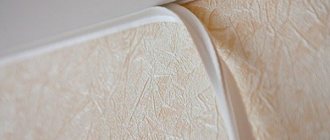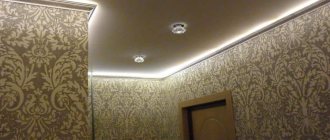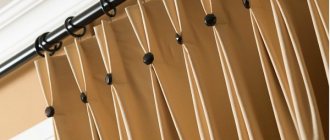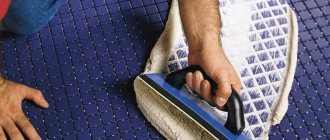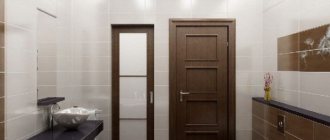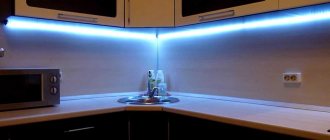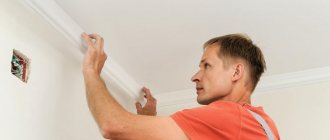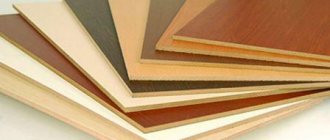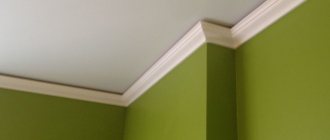When installing drywall, the strength of the surface must be ensured by sealing the resulting joints. Otherwise, natural deformations in wall or ceiling structures that accompany the installation of gypsum boards will cause the formation of cracks in the area of panel joints.
In the practice of dry repair, two types of reinforcing materials are most often used to level flat joints: self-adhesive tape for seams (serpyanka) and paper tape. Each of the materials has its own characteristics.
Why do you need putty joints?
Under the influence of moisture and high temperatures, drywall is subject to certain fluctuations. This is most evident in the weak areas of the plasterboard structure - the joints of the sheets. If you do not use joint tape during the process of filling gypsum board panels, after a while cracks will certainly form on them. At the same time, a special tape product will help prevent damage and facilitate surface leveling.
When installing plasterboard sheets, it is extremely important to seal all seams efficiently. Over time, mistakes made will certainly remind you of themselves and lead to considerable financial expenses. Therefore, the space between gypsum board panels should always be filled with reinforcement.
Types of reinforcing tapes
To strengthen the joints of plasterboard sheets, two types of tape products are often used:
- fiberglass;
- paper
Additionally, when finishing seams between drywall, the following tapes can be used:
- non-woven – reinforces corners;
- with metal strips – designed for reinforcing external corners;
- wide made of fiberglass - helps strengthen the junction of drywall and the wall, can have a width of 10 cm or more.
Serpyanka
It is a thin fiberglass mesh with a special adhesive composition on one side. To prevent the glue from drying out, it should be stored wrapped. In cheap products there is no sticky layer at all. They are attached using a construction stapler or laid directly on the putty.
The width of the serpyanka strip is 5 cm, the length of the roll is 20 m or more. This material is extremely easy to install; even beginners can easily handle its installation.
If self-adhesive fiberglass tape was used when sealing the seams, it must be packed in polyethylene after completion of the work. Otherwise, after a while the glue will dry out, causing the material to become unusable.
Important information! It is unacceptable to use serpyanka to reinforce internal corners or transverse joints. It can stretch even under a small layer of putty. In addition, there is a high probability of cracks forming at stressed seams.
Paper
Tape for plasterboard joints is made from durable paper containing transverse and longitudinal fiberglass reinforcement. To make it easier to handle internal corners, it has a special fold. This product is produced in rolls of various lengths with a standard width (5.2 cm).
For beginners, using paper tape is much more difficult than using sickle tape. If there is not enough putty, air will accumulate under it and bubbles will begin to form. To avoid such problems, it is better to use perforated products.
Compared to fiberglass tape, paper tape is considered less convenient to use. But at the same time, it is superior to serpyanka in a number of parameters:
- more affordable;
- the minimum thickness of the material allows it to be used when strengthening completely finished surfaces;
- goes well with putty and drywall, is completely invisible after drying, and provides special strength to the seam.
To improve adhesion to gypsum board panels, roughness is provided on the adhesive side of the paper tape.
How to glue serpyanka and paper tape to drywall joints
- Has a high level of strength.
- It is durable and will last all those years that will pass until the next repair.
- Not afraid of aggressive environments.
- Tolerates shrinkage and vibration loads well.
- Prevents the appearance of cracks due to the formation of strong adhesion to the binder (putty).
- It has a relatively low cost.
Using a narrow spatula, putty is applied along the entire length of the seam. Then sickle tape is glued on top of the putty. At first, you can simply press it with your hands. However, after this you need to run it over it with a wide spatula with slight pressure several times.
Due to its cellular structure, the sickle for drywall will allow putty to pass through it. It will come straight out through the cells. The serpyanka will be pressed in more strongly, and excess putty will be removed with a spatula. The serpyanka for drywall is a thin mesh tape made of fiberglass.
Typically its width ranges from 4.5-23 cm, and it is used to reinforce drywall joints. Not a single large plasterboard structure can do without the use of reinforcing tape at the puttying stage. This tape allows you to avoid cracks in the finishing layer. Paper tape can also be used for these purposes, but we will talk about it a little later.
There are two approaches to how to glue serpyanka to drywall. In the first case, it is glued to the seam due to its adhesive surface. After this, putty is applied to it, which secures the sickle and reinforces the seams.
However, the second approach is considered more correct. Putty is applied to the joint transversely to the seam line. After this, it is smoothed out with longitudinal movements, and then a reinforcing tape is laid on top.
Sealing drywall seams with paper tape is done using a wide spatula.
How to treat the surface → Room decoration → How to choose the right paint → Surface treatment technologies → Leveling and finishing the walls → Selecting and applying a primer → Removal from the surface → Stretch ceilings and technologies → Reviews and testimonials
Self-adhesive reinforcing mesh
In construction, serpyanka is used for sealing small holes, cracks, and processing seams formed by gypsum plasterboard sheets with a thinned edge. Products of many brands demonstrate high tensile strength.
Gluing serpyanka to seams
Serpyanka, in turn, is divided into non-self-adhesive and self-adhesive.
The first option is somewhat cheaper, but the process of sealing seams is more labor-intensive, since they are fastened with special paper clips. When using self-adhesive sickle tape, make sure that the packaging is sealed, otherwise the adhesive layer may dry out.
Mixtures for sealing joints in drywall
To reinforce the joint, you should choose the right mixture. The material used must be gypsum based and have good adhesion.
Knauf Fugen - putty produced by specialists for sealing seams between plasterboard sheets. But, sometimes it is used as an adhesive.
Knauf Uniflot is a durable waterproof mixture. After drying, this putty does not absorb moisture, so it is intended for rooms with high humidity. When using putty, reinforcing tape is not needed. The mixture is also used to seal cracks on plasterboard surfaces.
Semin CE78 - “New Formula” is intended for sealing seams in plasterboard construction. It has sufficient strength, does not crack after drying, and reinforces joints well.
JS weber vetonit is a polymer putty for sealing drywall joints. The maximum thickness of applied putty is up to 5mm.
Volma Shov is a non-shrinking putty mixture intended for reinforcing seams and correcting defects on drywall. The thickness of the applied putty is up to 5mm.
Damper
Such finishing is an important component of gypsum plasterboard structures. It is made from polyurethane foam. The damper tape is installed under the starting profile, its width is from 3 to 10 cm depending on the selected profile, its thickness is from 3 to 5 mm. One side of the tape is coated with adhesive, which makes it easier to attach.
Damper tape is a strip made of polyethylene foam
Working with perforated corner-forming tape
Be that as it may, perforated paper tape for drywall was created. The logical interaction of paper tape and the cardboard surface of the plasterboard sheet greatly increases the reinforcing properties of the tape and significantly strengthens the formation of corners and joints.
However, it is worth noting that it is better to use an aluminum perforated corner to form the external corner. It is more durable and really protects the corner from minor impacts.
When working with perforated tape for drywall, as always, there is a different approach. The first one recommended by the manufacturer. Second, from practitioners.
For all manufacturers of perforated reinforcing tape, the recommended method of application is approximately the same.
- Apply a layer of putty to the joint of the sheets;
- From the ceiling to the floor, continuously stick the tape to this layer;
- From top to bottom, slightly holding the tape at the top, press the tape into the putty layer with a narrow spatula. Remove excess putty from the wall with the same spatula;
- Wait until it dries and cover the tape with a second layer of putty;
- After the second drying, you can proceed to sanding the joint.
The second option for working with tape is similar to the first, only before using it, the tape is soaked in a bucket of water. Let me explain the difference between these methods.
The classic (let's call it that) KNAUF-Kurt reinforcing tape contains reinforcing synthetic fibers. They prevent the tape from stretching when the putty absorbs moisture. This prevents the tape from swelling when wet and warping when it dries further. This is exactly the tape that is applied to the putty joint.
Other manufacturers, such as Unibob, do not add synthetic fibers to the tape. As a result, if this tape is not wetted with water before use, it will take water from the putty, get wet unevenly and, as a result, go in waves. That is why the tape is wetted before use.
In addition, for gluing perforated tapes it is better to use special putties for seams. They are less wet and interact better with paper. For example, KNAUF-Fugen putty or Volma Seam.
Sealing
The tape must be glued according to certain rules and under certain conditions.
Consider the following factors:
- Observe the temperature and humidity conditions. The positive temperature in the room should not fall below ten degrees, drafts are completely excluded.
- Surfaces after wet work should dry thoroughly.
- The sheets must be firmly attached to the frame, otherwise the sealing tape will not fulfill its mission.
- The screw caps should not protrude above the surface.
And then - about how exactly you need to glue the tape.
Sealing technology
Before you start processing the joints of plasterboard sheets, they need to be prepared in advance:
- Using a paint knife, make chamfers (if there are none).
- Sand the seams (remove burrs), then clean them thoroughly: preferably blow them with a stream of air.
- Prime the joints. For this, it is best to use an acrylic solution.
Laying serpyanka
In most cases, fiberglass tape is glued to the putty, but sometimes it is laid over a dry base.
When implementing the first option, you must perform the following steps:
- Prepare the putty mixture. You need to mix the solution in small portions so that you have time to fully use the material before it begins to lose its qualities.
- Fill the seams with putty using a narrow spatula.
- Apply a thin layer of the mixture to both sides of the drywall. It is advisable that its width is slightly larger than the size of the tape.
- Lay the serpyanka, starting from the top. When you have to use several pieces of material, their edges must be overlapped. The excess is carefully trimmed with scissors.
- Gently smooth the solution and remove any excess. The mesh should be completely immersed in the putty.
- Wait until the composition is completely dry. This will take about ten hours.
- Apply a finishing layer of putty mixture. Its main purpose is to eliminate minor errors.
- After the material has dried, carefully sand the seam with fine-grained sandpaper.
- The next stage involves applying primer and filling the entire surface.
It is also possible to lay adhesive or regular serpyanka dry. To do this, the material with an adhesive base is glued to the surface, and in the absence of self-adhesive, it is fixed with a stapler along its entire length. A layer of plaster is applied on top, which is then smoothed.
Laying paper tape
It is recommended to use strips of special paper to seal transverse joints. In these areas, it provides much greater strength than serpyanka and helps avoid the appearance of cracks in the future. When attaching a perforated product, you must adhere to the following procedure:
- Fill the prepared seams with putty.
- Apply a layer of homogeneous mixture completely covering the tape. If the composition used contains lumps, it will be impossible to hide them with thin material.
- Place a stretched tape in the middle of the seam, press it into the putty mixture and, starting from the center, smooth it out with a spatula. The pressure on the material should not be strong, but at the same time sufficient for strong adhesion. Do not squeeze out all the putty, otherwise the tape will not be able to stay on the drywall.
Advice! Since the putty mixture dries quite quickly, it should be applied gradually, to small areas of the joint.
When laying reinforcing paper tape, it is extremely important to prevent the formation of air bubbles under the material. Therefore, it is much more convenient to use products with holes through which air subsequently escapes.
Excess putty, squeezed out from under the paper with a spatula, must be removed in a timely manner so that it does not have time to dry out. The finishing layer is applied after the material has dried. Then the putty strip is carefully sanded and the entire surface begins to be puttyed.
After proper treatment of the space between the plasterboard sheets, the plane is finished using the traditional method - plaster mixtures using reinforcing mesh. Subsequently, the resulting base can be finished with any material.
The process of sealing seams using self-adhesive serpyanka
To reinforce the longitudinal joints formed by two sheets of gypsum plasterboard, self-adhesive mesh is used. Much less time is spent on the sealing process with serpyanka, since it is easier to use. The danger of air bubbles is not terrible for the serpyanka; they do not worry about it.
The disadvantages of using serpyanka include:
- Reduced level of strength compared to paper tape;
- Selecting the appropriate type of putty solution.
Applying a plaster layer over serpyanka
If the joints are treated with serpyanka, then experts recommend carefully applying it to all the seams of the room. Before applying the reinforcing mesh, the surface is dust-free, otherwise the formation of wrinkles cannot be avoided. When gluing the serpyanka, press it well against the wall or ceiling. Afterwards, a layer of putty material is applied over the mesh and into its depth using a spatula. The putty layer should be uniform and thin.
The following video clearly demonstrates all the subtleties and nuances of gluing paper tape:
Selection of adhesive composition for fastening serpyanka
There are many types of gypsum plasterboard glue for gluing serpyanka to drywall. Some representatives of the mesh are already produced with a self-adhesive base. However, an additional adhesive composition is still applied to the standard glue, which enhances its functions and the sealing of drywall joints will be reliable. You should consider the most popular adhesive mixtures.
Paper tape and fiberglass-based serpyanka stick well to PVA glue. However, it should be taken into account that if the surface on which the glue is applied is concrete, then PVA is not an effective enough mixture.
Bustilat
Reinforcement of plasterboard joints with serpyanka is carried out using bustylate. A paper tape is attached to it, which is often used on flat joints.
putty
Attaching sickle tape or paper tape with putty is one of the most common methods. This conclusion was made by many experienced masters. The essence of this technique is quite justified. If we take gypsum plasterboard sheets as an example, then before gluing the reinforcing tape, the joints of the sheets must be slightly expanded. The putty allows you to simultaneously seal the seams and will serve as an adhesive mixture for the serpyanka.
High-quality putties are recommended for use in cases where gypsum board or other material is joined to a plastered wall under wallpaper.
Rules for sealing seams using Knauf tape
Fiberglass mesh is an excellent material for sealing seams formed by gypsum board sheets with a thinned edge. But its strength is not enough to seal transversely located seams. Paper tape will reduce the risk of cracks in these places. It forms a seam of extreme strength, regardless of the chosen brand of putty. But the sealing of seams will be of high quality only if certain subtleties of the work are observed:
- Knauf does not have an adhesive base, so a uniform thin layer of putty solution is applied to the joint, which will act as glue;
Sealing seams using paper tape
- The putty solution, especially a thin layer, dries quickly enough, so do not apply putty to all joints at once. Otherwise, the work process will become somewhat more complicated, and air bubbles may form;
- The tape is adjusted in the center of the seam. Holding it in a taut position, applying slight force, press it into the layer of putty. Its ends overlap when crossing;
- From the center to both sides of the seam, use a spatula to “stretch” the glued tape. In this case, a force is applied so strong that it is sufficient for reliable gluing, but so that an excess amount of putty solution is squeezed out. There should be approximately 0.8 mm under the edge, 2 mm under the middle of the tape. If too much putty is squeezed out, the tape will have nothing to stick to;
- After completing the gluing stage, smoothing out wrinkles, they remove the excess amount of putty solution that has formed on the longitudinal edge;
- Then, after the putty material has completely dried, using a spatula with a wide blade, more than 100 mm, the seam is finally smoothed out. Attention is drawn to the fact that the layer of putty mixture on the plasterboard sheets forms a single plane. For the process, super-thin putty solutions from Knauf or Semin are used;
- The last stage is sanding.
How to glue serpyanka correctly: instructions
Pasting of joints with serpyanka is carried out in the following places:
- on flat surfaces;
- in the inner corners;
- in outer corners.
In order to properly stick sickle tape, you do not need years of experience, however, it is still necessary to follow some rules.
Option 1
- before sealing the seams, they should be primed with antifungal liquid to increase adhesion;
- the next step is to fill the drywall seams with putty;
- Next, a sickle 45 or 100 mm wide is glued onto the undried solution;
- The sickle should be evenly pressed into the putty layer so that the solution begins to protrude through the mesh holes.
The serpyanka is smoothed out so that it does not stand out during subsequent puttying of the walls. The mesh can be replaced by paper tape 100 mm wide; you need to know that it is not so plastic and absorbs moisture much more.
The process of gluing a seam with serpentine tape
Before applying paper tape to the joint, it must be soaked in water, otherwise the putty material may crack due to rapid dehydration.
Option 2
The second option for sticking serpyanka 45 or 100 mm is done using glue, for example, PVA.
In such cases, pre-embroidered gypsum board joints are primed. Next, a layer of glue is placed in them, and the joint surface on which the tape is attached is lubricated with it.
Of course, this method is simpler than the first. The question arises: how to putty seams correctly? It is necessary to take into account the fact that the joints turn out to be fragile and loose, and the serpyanka takes on additional loads. Fiberglass is a durable material, but when sealing seams it is better to prevent cracking using a special putty. The video shows how to properly glue serpyanka.
Which is better: heated floors or radiators?
Warm floorBatteries
As for processing internal or external joints, the technology for gluing 100 mm protective tape does not differ from that described above. However, in the case of external corners, it is preferable to use profiled corners, which will greatly facilitate the ability to smoothly putty the seams. It is recommended to treat drywall joints with a second layer eight hours after pasting.
The main types of tapes used for sealing seams
To strengthen the joints of sheets of plasterboard structures, two types of tapes are most often used:
- serpyanka, consisting of fiberglass;
- paper reinforcing tape.
In addition, when finishing drywall joints the following types of tapes can be used:
- Non-woven or bandage - to strengthen the corners.
- With metal strips - for reinforcing external corners other than 90 degrees.
- A wide piece of fiberglass to strengthen the joint between drywall and the wall, for example when constructing an arched structure in a doorway. It can have a width of 10 cm or more.
Advantages and disadvantages of the device in question
Like any device, tape has its advantages and disadvantages.
The following qualities can be noted as the main advantages:
- Affordability.
- Possibility of strengthening seams and sheet joints.
- Stable relationship to aggression.
- Tolerates vibrations favorably.
- Has an excellent level of grip.
But other minor disadvantages include:
- Probability of medium strength level.
- A special choice of putty is important.
Useful tips
In order to obtain the highest quality result after sealing plasterboard joints, during the work process it is necessary to follow the following recommendations of specialists:
- Ensure optimal temperature (more than 10 C°) indoors. It is also extremely important to eliminate drafts.
- In conditions of excessive humidity, the tape for sealing gypsum board joints will not adhere well. Therefore, its installation should be planned after the completion of wet finishing work.
- Before you begin laying the reinforcing tape material, you need to make sure that the drywall is securely fastened.
- If there is no chamfer at the joints of the gypsum plasterboard, you definitely need to apply it yourself.
- To prevent cracks from appearing in the corners over time, they should be filled with putty carefully and evenly.
- When special tape is not used to finish the corners, ordinary tape must be folded in half, then glued to the seam.
- Before using putty, you need to read the information on its packaging. Some compounds are incompatible with reinforcing tapes and are not able to hold them at the joint.
- If air bubbles have formed on the paper tape material, they should be pierced with a needle, then the air should be removed.
- To process joints that are too long, it is advisable to divide the reinforcing products into meter-long sections, which are then glued in stages.
Required Tools
To carry out DIY work, the following devices are used:
- Planer-rasp (roughing plane ). Designed for leveling and cleaning the edges of sheets. For drywall, peeling and edging tools are used. The first option is a metal block with handles and a grater underneath. The second type is special knives that allow you to cut a chamfer at the desired angle.
- Spatulas . For embedding you need a wide, narrow, and also an angled spatula. It is advisable to have a tool with a metal and rubber blade. Wide spatulas have sizes of 45, 60 and 80 cm, and narrow spatulas - 15 and 25 cm. The best quality tools are from Kraftool, Ansa, Armero, Sheetrock, Storch.
- Abrasive tool . For manual processing of sealed seams, an abrasive block, a block fixed to a special device, or a grater with a telescopic handle are used. The last option is suitable for ceilings. The most common finishing tool is sandpaper. For initial rough processing, you need coarse-grained paper with numbers in the range of 20-200, and for final processing, fine-grained grades with numbers of 250-2000.
In addition to the basic devices, additional and monitoring tools will be required. For priming you need paint brushes of different widths. You can correct edge defects with a sharp knife. Quality control must be done at the construction level.


